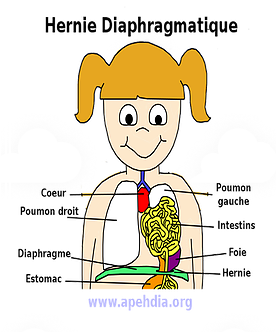WHAT IS DIAPHRAGMATIC HERNIA?
Diaphragmatic hernia is a rare disease (one to five per 10,000 births) whose origin remains little understood.
The diaphragm is a respiratory muscle separating the thorax from the abdomen. Diaphragmatic hernia is a defect in closure of the diaphragm, enabling passage of abdominal viscera (intestines, stomach, liver) into the thorax, leading to respiratory insufficiency.
In 70-80% of cases, the hernia occurs on the left side.

HOW IS THIS MALFORMATION DIAGNOSED?
The disease is usually discovered at birth (80% of cases), but may also be discovered after birth.
During pregnancy, it can be discovered during the prenatal ultrasound by observation of abdominal organs abnormally present in the thorax. The heart may also be displaced or compressed. Research is in progress on foetal surgical techniques (insertion of a balloon in the foetus’ trachea in the hope of stimulating growth of the lung compressed by the hernia).
Diaphragmatic hernia is found in different forms, of varying severity, as a function of the amount of organs present in the thorax, the size of the remaining lung and the earliness of discovery. It is isolated in most cases, but more rarely it may be associated with other anomalies. A general examination is then necessary. However, most cases are sporadic, and the risk of recurrence in the family is low (2%).
WHAT IS THE TREATMENT?
Care is provided to the infant starting at birth. The infant is first intubated to provide immediate respiratory assistance and is then transferred to the neonatal ICU for monitoring and stabilisation of vital signs.
Once the infant's health has become stable, an operation is scheduled to put the intestines and liver back in place in the abdomen and to close up the diaphragmatic opening.
At birth, CDH is a generally severe disease for newborns. The mortality rate depends on the parameters measured during pregnancy, on adaptation at birth, on the form of the hernia seen during the operation, and on the post-op period.
The extent of the hernia and the evolution of vital signs will determine the length of the hospital stay: from a few weeks to several months.
After the infant leaves the hospital, regular, long-term follow-up will be put in place.
Relevant reference centre:
Patients association :
Sources
Learn more :
- Orphanet
- PNDS (French national diagnosis and care protocol)
- Information booklet intended for parents


